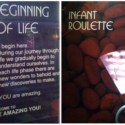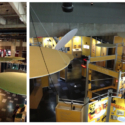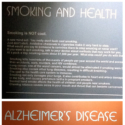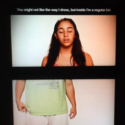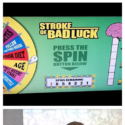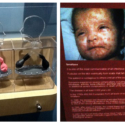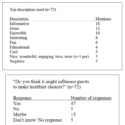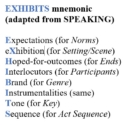Reports and commands: deciphering a health exhibition using the SPEAKING mnemonic
Article DOI: https://dx.doi.org/10.15180/211605
Abstract
The Amazing You exhibition at the Tampa Museum of Science and Industry had over 400 different multimedia health exhibits. Visitors walked through life stages, from conception through death, the exhibits at first showcasing developmental milestones, then diseases and chronic conditions associated with ageing. Museum executives described the exhibition as a public health intervention that stressed disease prevention, screening and behaviour change. This piece considers the question: What makes an exhibition be a health intervention?
To describe complexities of the communication environment I use a mnemonic device called SPEAKING, an acronym for ‘Scene/Setting, Participants, Ends, Act Sequence, Key, Instrumentalites, Norms and Genre’ (Hymes, 1974). This methodological tool from the ethnography of communication approach provides explanatory concepts from speech act theory, the interactional view of communication, and frame analysis. SPEAKING is an order of inquiry for understanding multimodal environments in museums, especially those that try to change behaviour. Using examples from exhibit descriptions and interviews, I consider the communicative dimensions of The Amazing You using SPEAKING. This work is intended for exhibitors, museum curators and researchers interested in informal learning and behaviour change.
Keywords
health communication, science centres, SPEAKING mnemonic, speech acts
Introduction
https://dx.doi.org/10.15180/The Amazing You at the Tampa Museum of Science and Industry (MOSI) was a ‘permanent’ exhibition which lasted from 2008 until 2017, when the museum downsized (Contorno, 2017). It had over 400 different exhibits focusing on human health. The exhibition was built for $700K USD using funds raised from private health insurance companies, and county, state and federal agencies. Local hospitals, medical practices, biotechnology companies and device manufacturers helped to design and furnish each exhibit in exchange for prominent branding as sponsors. For example, an ophthalmology practice provided graphic eye surgery footage, and cord blood and tissue cryopreservation service CryoCell provided a sprawling stem cell exhibit.
The exhibition used a ‘lifespan’ design, which MOSI staff claimed had not been tried before. Visitors entered the pregnancy area and walked through exhibits about childhood, adolescence, adulthood and old age, culminating in an unsentimental exposition of dying. Diseases, injuries and medical conditions were introduced within the life stage they typically appear, and as a result they became the predominant focus from middle age, onwards. With exhibits about diet, exercise, neural development, drunk driving, heart disease, cancer, stroke, Alzheimer’s, etc., the focus was on ‘what it takes to stay healthy at each life stage’ and ‘how to return to wellness after an illness, surgery or a disability’ (‘The Amazing You’, n.d.).
To give a sense of the exhibition as a whole, just a few highlights are mentioned here: ‘Beginning of Life’ was an exhibit about conception and gestation, which contained ‘Infant Roulette’ (about prenatal injuries resulting from smoking, drinking, etc.) and a collection of foetal remains; ‘Childhood’ and ‘Adolescence’ contained ‘Risky Relations’ (about STDs), and ‘Healthywood Squares’ featured animatronic puppets. ‘Early Adulthood’ had ‘Choices for Longevity’ (about behaviours implicated in higher rates of morbidity and mortality) and ‘Smoking and Health’ (about one such unhealthy behaviour). In ‘Older Adulthood’ the focus turned to degenerative diseases associated with ageing, including heart disease, stroke, Alzheimer’s and cancer. Finally, ‘End of Life’ contained exhibits on organ donation, ‘Cultural Death Rituals’ and a ‘Legacy Station’ where visitors wrote the name of a loved one on a slip of paper and saw it blown around in a Bernoulli blower.[1]

The Amazing You was conceived of as a public health intervention, I learned from interviewing MOSI’s chief executive and lead designer. It was a response to the blockbuster Bodies exhibition that came to The Museum of Science and Industry in 2007. The plastinated human remains of Bodies were organised by system (skeletal, circulatory, digestive, etc.). While the CEO found Bodies informative, he wanted a follow-up exhibition with more explicit emphasis on getting visitors to “eat right, exercise, and get screened for problems on the horizon”. Getting visitors involved in their own health and recognising themselves as candidates for disease was something that the systems approach in Bodies did not do enough of, he felt.
This essay uses data collected from a larger study as case examples. The aim of the paper is to consider the question: What it is that makes a health exhibition an intervention? To research this question, I use an analytical rubric from the ethnography of communication called SPEAKING (Hymes, 1974). This is a mnemonic device which stands for:
• Scene/Setting
• Participants
• Ends
• Act Sequence
• Key
• Instrumentalites
• Norms
• Genre
Although originally used to describe conversations, rituals and other oral communication events, with some adaptations, SPEAKING can be applied to a museum exhibition with illuminating results. In this essay I apply each component of SPEAKING to The Amazing You, to better understand what makes an exhibition a health intervention. I conclude with a discussion of the implications of SPEAKING for curators, administrators and researchers. First, however, the research process and data corpus are detailed.
Methods and data
https://dx.doi.org/10.15180/211605/002In the winter of 2012–2013 references videos were recorded (on smart phone and tablet) from the perspective of an end user, pressing buttons, turning levers and otherwise interacting with each exhibit. 18.8 gigabytes of videos would later be transcribed by creating 120 pages of textual descriptions. In between the recordings, the actions of other visitors were sometimes observed, and field notes were recorded using the phone or tablet. Upon IRB approval, interviews were conducted with MOSI’s Chief Executive, the Vice President of Design and Vice President of Grants and Research. I was provided with a ‘Researcher’ badge, and tables and chairs were placed at the exit of the exhibition. There, visitors leaving the exhibition were asked if they would complete a short exit survey. The survey was a single piece of paper with open-ended questions such as ‘What are your thoughts about The Amazing You?’ and ‘How do you think The Amazing You might influence guests to make healthier choices?’. The final question asked if they might be willing to sit for an approximately 15-minute interview, in exchange for free tickets to an IMAX movie. 72 surveys were collected, and 21 interviews conducted and transcribed, with visitors, volunteers and executives.
A grounded theory approach to data analysis is inductive in that it does not begin with any predetermined hypothesis or theoretical framework. While I did not have a predetermined hypothesis to test, I decided to code according to the apparent communicative action being performed by each exhibit, given the Museum of Science and Industry executives assertion that The Amazing You went beyond simple information transfer. Using textual descriptions of exhibits and interview transcripts, each exhibit (or a part of an exhibit) was coded according to its purpose, stated or implicit, using the gerundial ‘-ing’ form of an action verb. For example, I coded an exhibit that shone an infrared camera on the visitor’s face as ‘warning’ about the risk of skin cancer. I coded as ‘informing’ an interactive database where visitors looked up surgical procedures. An audiometry test screening for hearing loss was coded as ‘diagnosing’. Exhibits with titles in the imperative grammatical mood (such as ‘You Be the Doctor’, ‘Do This, Not That’, and ‘Live Forever!’) were coded as ‘commanding’.
After this open coding process (Strauss and Corbin, 1990, pp 62–69), I used axial coding (Ibid, pp 96–115), which involved making a second pass over the coded transcripts, finding similarities between the codes and grouping them into larger umbrella categories. Four umbrella terms were derived from this process: describing, prescribing, entertaining, and diagnosing. Each verb characterised the apparent purpose of an exhibit (or component within an exhibit). While descriptive exhibits imparted knowledge, but did not have any particular action step to take, prescriptive exhibits told the visitor what to do to stay healthy. Entertaining exhibits included a wall of jokes and one-liners called ‘Laughter is the Best Medicine’, while diagnostic exhibits measured the visitor’s weight, blood pressure, vision and hearing abilities. Usually, exhibits worked towards more than one of these ends. For example, the heart disease exhibit contained an informative video (descriptive); a titular plea to ‘Take Care of Your Sweet Heart’ (prescriptive) and a blood pressure monitor (diagnostic) (Lee, 2018). The wish to characterise exhibits according to communicative purpose led to my discovery of the ethnography of communication approach and the SPEAKING mnemonic.
Using the SPEAKING mnemonic
https://dx.doi.org/10.15180/211605/003More details about the process of data analysis are provided in the sections on SPEAKING which appear below. First, I discuss why SPEAKING appeared to be a promising methodological tool. Finding extant frameworks to analyse the communicative situation at The Amazing You was challenging, given the numerous forms of communication documented. While discourse was abundant on text panels, there was also non-verbal communication in the form of illustrations, photos, videos, models and diagrams, as well as looped dialogue and pre-recorded sounds. Surely a message was being transmitted from the exhibitors to the visitors, but a simple sender/receiver model (Shannon and Weaver, 1949) didn’t account for the chorus of medical communities of practice who were involved with creating each exhibit. Neither did it account for the variety of visitors, of different ages, genders, races, socioeconomic status and risk-profiles, who I met doing surveys and interviews. There is a literature on museums as communication systems (De Borhegyi, 1963; Cameron, 1968; Hooper-Greenhill, 1991) that helped characterise audio, visual and tactile channels of communication, as well as components such as exhibitor, exhibition and visitor. However, this framework did not account for the overall purpose or function of an exhibition. In the words of early health exhibit designer Bruno Gebhard (1940, p 657): Do health exhibits mainly inform? Or is the final aim ‘to impel action for better and healthier living’?
A key consideration of the ethnography of communication approach associated with Dell Hymes and colleagues is communicative purpose. Communication functions to pass along information, but also to express feelings, connect with others and issue commands, among other functions (Saville-Troike, 1989, p 14). The SPEAKING mnemonic (Hymes, 1974) is an order of inquiry used to categorise multiple dimensions of any communicative event. SPEAKING accounts for the event (Scene or Setting), the various interlocutors (Participants), the overall purpose (Ends), and the more minute order of communicative acts (such as question/ answer, etc.), which further the achievement of these ends (Act Sequence). Additionally, SPEAKING prompts the ethnographer to note the mood of the event (Key), the various channels or modes of communication employed (Instrumentalites), and the expectations participants bring to the encounter (Norms and Genre). Although originally envisioned to describe conversations, rituals and other oral communication events, I argue that SPEAKING can, with some adaptations, be applied to a museum exhibition with illuminating results.
In what follows, I describe the SPEAKING mnemonic using examples from The Amazing You. The goal is to show how SPEAKING might help researchers gain better insight into the social functions of exhibitions. I hope it will also be useful to curators and exhibitors looking to design more effective and engaging exhibits, with underlying goals of changing the world for the better. (For example, to advance public health, or fight climate change, racism, etc.)
Setting/Scene
According to Hymes (1974), ‘Setting refers to the time and place of a speech act and, in general, to the physical circumstances’ (p 55). ‘Scene’ refers to the ‘psychological setting’ or ‘cultural definition’ of a setting, which includes characteristics such as the sense of formality and informality (Hymes, 1974, pp 55–56). The Museum of Science and Industry tagline which appeared prominently on the website, ‘We’ve got fun down to a science’, suggested a balance between entertainment and scientific facts. Indeed, the precarity of this balancing act is a theme that will emerge below in the discussion of ‘key’. At the time this research was conducted, The Amazing You took up most of the Museum’s third floor, leading visitors through comb-like interstices created by six-foot standing panels, and directing them from one life stage to the next. Figure 2 includes photos of the exhibition floor, taken from above, on the fourth floor walkway leading to the administrative offices. Since the scene and setting of exhibition were already described briefly in the introduction, we can move on to the next letter making up the SPEAKING mnemonic.
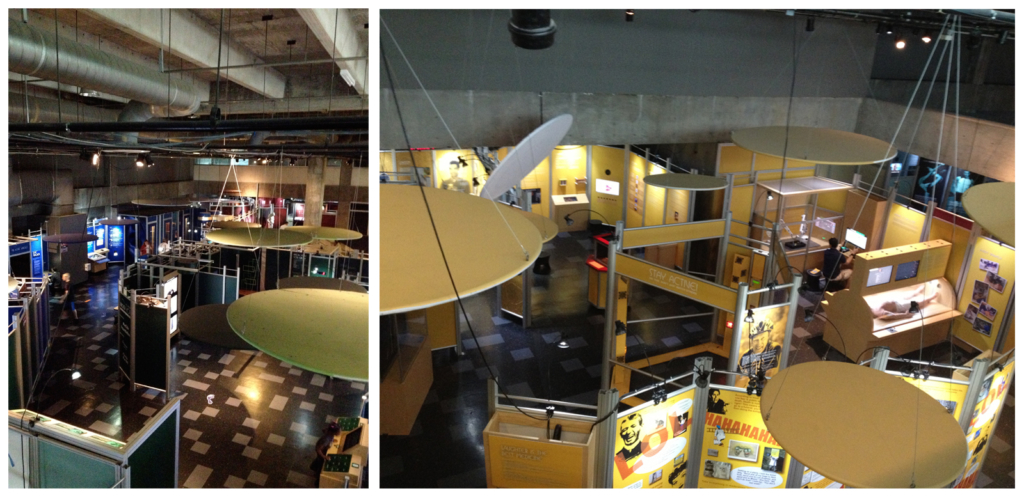
Participants
As noted, the ‘sender’ (exhibition) and ‘receiver’ (visitors) model of communication would be an oversimplification in this case. There were 156 members of the advisory council involved with the conception, design and fabrication of the exhibition. Some of these were medical experts while others were commercial sponsors. For example, prosthetic limb manufacturer West Coast Brace and Limb sponsored ‘The Cybernetic Human’, an exhibit featuring a shiny chrome mannequin fitted with artificial limbs and organs. One visitor noted that this exhibit was practically an advertisement for getting new body parts. “It makes getting a prosthetic into some super-hero thing, when a lot of times their leg was blown off by an IED, or they get a new hip ‘cause they’re overweight.” This example suggests that visitors noted the commercialism of exhibit sponsorship. In another example, a video booth showing a live birth was sponsored by a local hospital and appeared to take place in a hospital setting. A mother of two and proponent of home birth stated, “It assumes I’m going to go to the hospital. There aren’t any other alternatives considered.” This examples indicates that The Amazing You did not ‘speak’ in a single voice.
Neither were the ‘receivers’ monolithic. Visitors to The Museum of Science and Industry included school groups, local families and tourists visiting the nearby Busch Gardens amusement park. The second person pronoun, ‘you’, addressed various demographics. Sometimes, the ‘you’ of The Amazing You was a pregnant woman who is being told not to smoke during pregnancy. At other moments, ‘you’ was an adolescent being told to avoid peer pressure. Later in the exhibition, ‘you’ was an elderly person, being urged to complete crossword puzzles in order to postpone the onset of neurodegenerative diseases. In other words, the second-person, gender-neutral pronoun ‘you’ was being used throughout the exhibition to hail various classes of visitors. ‘You’ is an indexical pronoun that can refer to mum, dad, grandma or big sister, etc., depending on the intended audience.
Therefore, the participants included the cardiologists, neurologists, oncologists, ophthalmologists, etc., on the advisory board and the commercial sponsors of individual exhibits, as well as the numerous visitors, young and old. Finally, one might consider whether the exhibits themselves be considered as participants or ‘actants’ (Latour, 2005), insofar as they are messaging visitors.
Ends
For Hymes (1974), ‘ends’ refers to the purposes or intended outcomes of a communicative act (pp 56–57). A consideration of purpose was a guiding question of this research, as MOSI executives suggested that this was an exhibition which set out to improve health. For example, the lead designer said:
When we first started designing The Amazing You we wanted to make a difference in people’s lives. We found that the typical ‘how the body works’ approach doesn’t necessarily keep people healthy. It’s more about attitudes…about making wise choices for wellness.
The VP of research and grants related a similar origin story:
We really wanted to do a health-wellness exhibition. But there are a lot of them out there, and a lot of them just go with the different parts of the body, so you walk through the heart and the eye, and all that stuff. But it didn’t go far enough for what we wanted to do… We were going to create this exhibition so that it was different and unique… through the stages of life, and in each stage – what typically happens. You have information about mental health, about growth, about smoking, aging, driving drunk – that could cause physical harm…
The above quotes emphasise that The Amazing You was intended to be something different from the typical health and medical exhibition focused on anatomy or bodily systems. It is acknowledged in health promotion circles that the provision of information, as such, is not sufficient to affect behaviour. However, people who are provided with a reason for why they are being asked to do something are usually more amenable to doing it (c.f. Langer, et al, 1978). Louise Ravelli (2006) distinguishes between exhibits that inform and those that command (p 303). I was, at first, tempted to characterise an entire exhibit by the ‘end’ (such as ‘to inform’ or ‘to instruct’), until I noticed that most exhibits contained smaller, component communicative acts. This leads into the next letter in the SPEAKING mnemonic.
Act Sequence
Speech Act Theory (SAT) provides a system of classification for messages that do other things besides stating facts (including suggesting, ordering, or expressing feelings, etc.). While SAT considers an uttered sentence as the unit of analysis (Vanderveken, 1990), Hymes (1974) proposed that speech acts should be considered syntagmatically (p 55), that is, as they appear in pairs, triplets or other groupings, within a communicative exchange. For example, a statement can be used as the premise of a directive that follows, as in the couplet, ‘It’s cold! Shut the window’ or ‘Seat belts save lives! Buckle up’. Notice in these examples how a command in the imperative mood follows a statement in the indicative mood.
To illustrate this type of pairing at The Amazing You, here is a portion of text that appeared on a wall panel of the ‘Smoking’ exhibit: ‘Smoking is costly and hurts your health in numerous ways, from cancer, to heart disease and emphysema. Don’t start, and if you smoke, quit.’ In this act sequence, the propositional contents of the first statement (an assertion) provide a warrant for the imperative that follows.
Here are further examples of the assertion/imperative act sequence. Another smoking exhibit contained the sentences ‘You really don’t look cool smoking. Just don’t start.’ An exhibit called ‘Options, Options’, about alternative medicine, contains this pairing: ‘Even western medicine, though widely reliable, can have numerous side effects and risks. Educate yourself and assess everything carefully for your own use.’ In an area dedicated to the heart, a text panel said that heart disease ‘…is the number one killer of men and women…’ and therefore visitors should ‘take good care of your heart for a long and healthy life’.
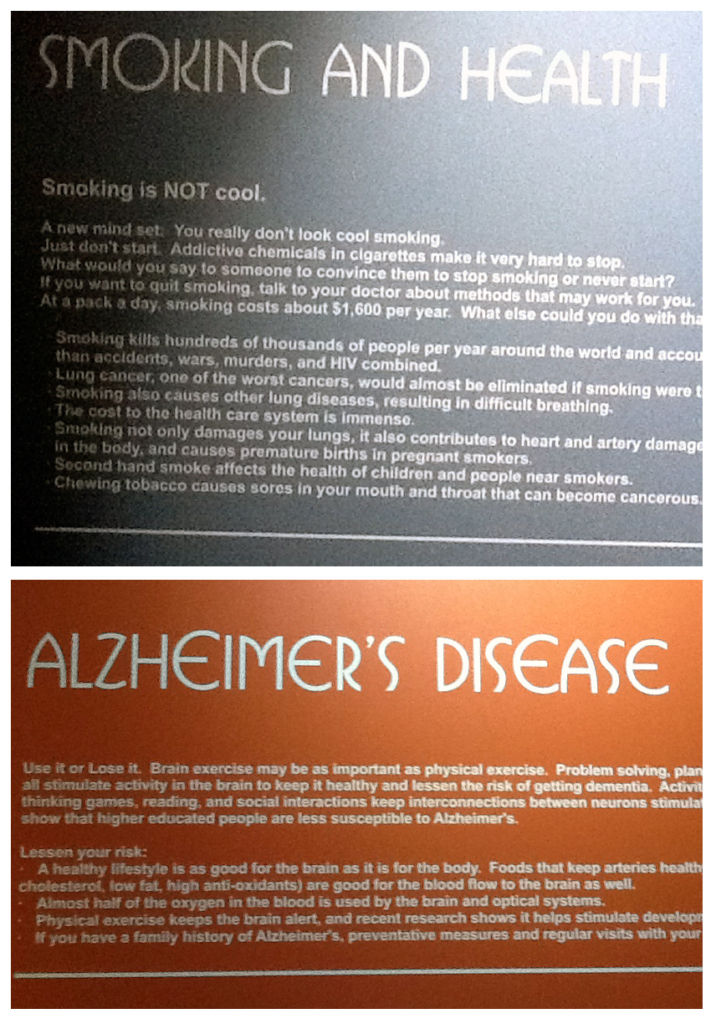
The sequence can also appear in reverse, with the imperative first. In an exhibit about Alzheimer’s disease, a panel says ‘Use it or lose it. Brain exercise may be as important as physical exercise’. Under the heading, ‘Lessen Your Risk’ it is stated ‘A healthy lifestyle is as good for the brain as it is for the body’.
One influential account of communication posits that any message contains both a report and a command element (Bateson, 1972; Watzlawick, Bavelas and Jackson, 1967).[2] A communication theory textbook states, ‘Report, or content, is what is said. Command, or relationship, is how it’s said’ (Griffin, Ledbetter and Sparks, 2014, p 167). According to this ‘interactional’ perspective, the ‘report’ is more or less what is explicit, while the ‘command’ provides (often tacit) information about how the addressee should interpret the message. ‘Indirect directives’ (Searle, 1975), an unrelated concept from SAT with interesting similarities, are commands that appear in some other grammatical mood, such as the indicative. Consider the statement ‘Only you can prevent forest fires’, uttered by US forestry advocate Smoky the Bear, which can be understood as a directive not to play with matches while camping. Because clinicians and health promoters don’t want to come across as controlling, bald imperatives can be disguised as statements. For example, take the statement ‘Quitting smoking now greatly reduces serious risks to your health’, which appears on cigarette packages in the US, functioning as a suggestion to quit. Information issued in the form of a report also contains tacit instructions about how to apply the information. These indirect directives collapse the assertion/imperative act sequence into one.
Here are some examples from The Amazing You of injunctions disguised as statements. ‘Unique, Just Like You’ urged young people to be accepting of differences. A teen appeared on a looped video saying, “It may be easier to spend time with people just like you, but you can miss out on a lot”. This statement provides a reason for teens to be more accepting, and it functions as suggestion for them to do so. For another example of an indirect directive, take the statement ‘There are over 4000 chemical compounds created by burning cigarettes, many of them toxic and/or carcinogenic’. This appeared in a smoking exhibit called ‘What’s in Those Things’. Below the statement, there was a list of hundreds of chemicals, including ammonia, arsenic, benzene and formaldehyde. Arguably, this exhibit functioned as a directive to quit smoking, even though there was no explicit imperative.
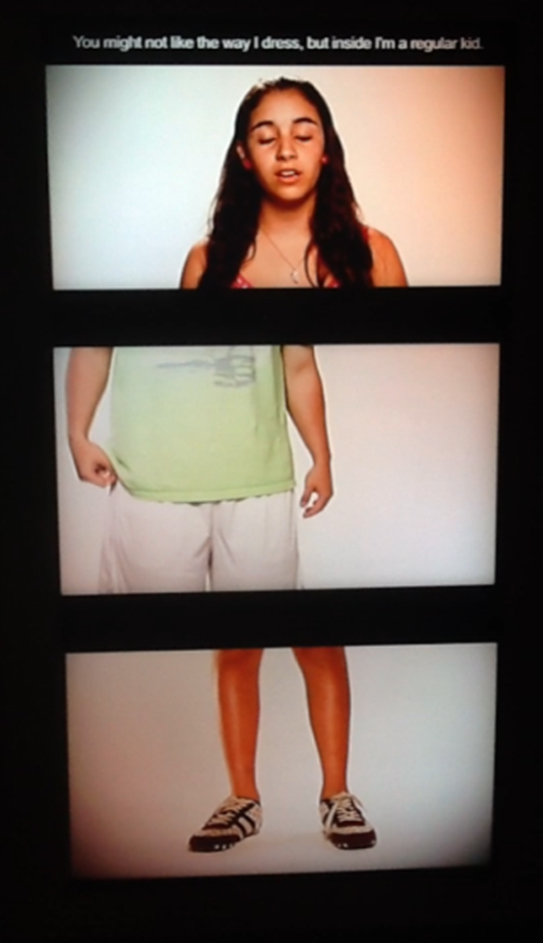
The insight, that commands may be disguised as assertions, allows for inferences to be made about the hidden meanings within exhibits. Appeals to stay healthy presume the issuer is an authority on the matter. The Amazing You makes a tacit claim about The Museum of Science and Industry’s institutional authority and the bona fides of medical and commercial sponsors. For health advice to be credible, it should come from an authoritative source, and issuing orders serves to exercise and reinforce this very same authority. The question of what makes an exhibition a health intervention appears to be closely related to the ratio of the report and command aspects of messages. Information is important, but to intervene on unhealthy behaviours, the message should at least contain clues, however tacit, on what the visitor is supposed to do with the information. As we make our way down each letter of the SPEAKING mnemonic, we turn now to the mood or tone of an exhibit, noting subtle changes in emphasis or manner.
Key
Keying describes switches in tone, from mock to serious, or from perfunctory to painstaking (Hymes, 1974, p 57). Hymes borrows the concept from Erving Goffman (1974) who describes play fighting among animals as closely patterned after real fighting, except that participants don’t get hurt. To Goffman behaviours (such as playful nips instead of bites) ‘transcribe’ the activity into something less lethal (p 44). Goffman uses a visual metaphor, describing keying as a ‘layer or lamination’ indicating the earnestness of any communicative situation (1974, p 82). The Amazing You had puns and cartoons that ‘key’ the exhibition as unserious, even when (perhaps) greater solemnity was warranted by the topic. Take, for example, an exhibit where a spin of the roulette wheel lands on one of the serious, debilitating injuries caused by cerebrovascular events, called ‘Stroke of Bad Luck’.
In a further example of this uneasy mix of serious and playful elements, a young man visiting MOSI with his girlfriend said about ‘You, M.D.’ (where visitors interacted with an onscreen, computer-animated doctor):
Some of this stuff is just kind of creepy… It’s like a horror movie. Like the bad guy’s basement, or something. That one doctor… The surgeon guy? And he’s animated? That’s like, weird. He has this, like, almost homicidal look on his face! [laughs].
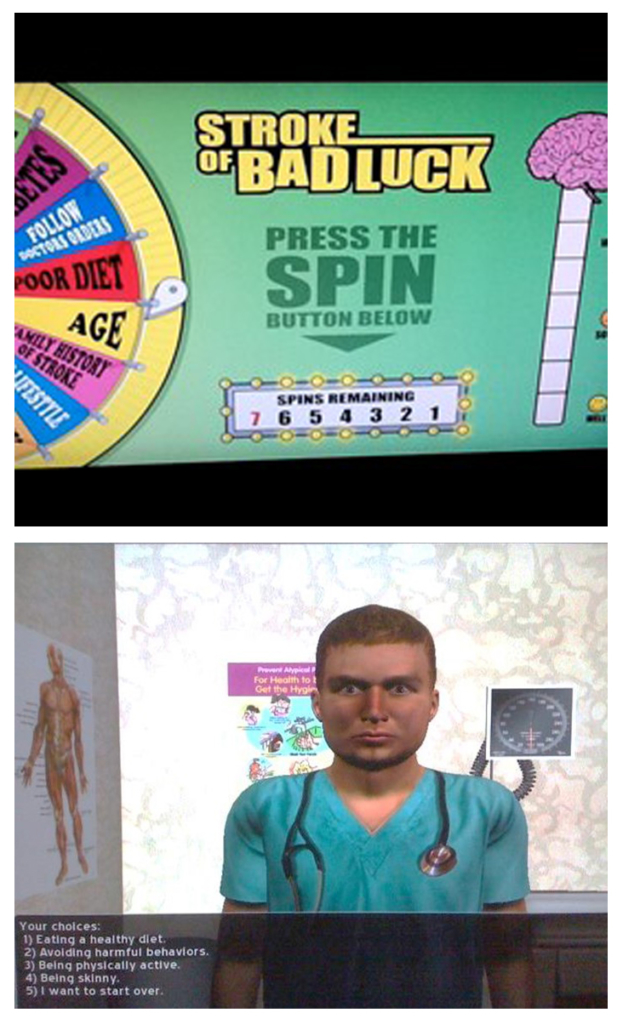
Shifts in key require participants to adjust their expectations about what sort of interaction they are having. The shift is not always from earnest to playful. Canny to uncanny will also suffice. For example, ‘Cancer Answers’ at the end of the adulthood section, showed video-taped testimony of three speakers, including a male doctor, a female doctor and a woman who had survived cancer. The keying is strange, because all three of the speakers’ faces were projected onto a mannequin dummy head, placed in front of a black velvet background. The three speakers look like a single disembodied head floating in space. The audio modality doesn’t seem to be in the same key as the visual.
Instrumentalities
https://dx.doi.org/10.15180/211605/004‘Instrumentalities’ describes forms and styles of communication (Hymes, 1974, pp 58–60) including modes, such as spoken/written, verbal/non-verbal or auditory/visual. Arguably, indirect directives can be observed in other modes besides verbal. Among the smoking exhibits there are two pairs of lungs, represented by balloons. One set inflates, but the other has holes in it. In the context of a health exhibition with a stated interventionist purpose, is this exhibit not an exhortation to quit smoking? How verbally explicit (or inexplicit) need an exhibit be to function as a directive?
To better understand indirect directives, it helps to introduce two technical terms from rhetorical studies. First, a syllogism is a type of argument composed of a major premise, a minor premise and a conclusion, which necessarily follows from the premises. The canonical example of a syllogism is: ‘All men are mortal. Socrates is a man. Therefore, Socrates is mortal.’ An enthymeme is, typically, a syllogism with the conclusion (or some component proposition) unstated. If all men are mortal and Socrates is a man, it goes without saying that he is mortal. No explicit conclusion is necessary. Visual arguments are enthymemic (Blair, 2004) because they can function as a logical ‘proof’ of sorts, even if they do not do so verbally. When the ‘Body Armor’ exhibit at The Amazing You shows photos of children, stricken with smallpox and other vaccine-preventable diseases, they arguably function as a directive to parents to have their children vaccinated.
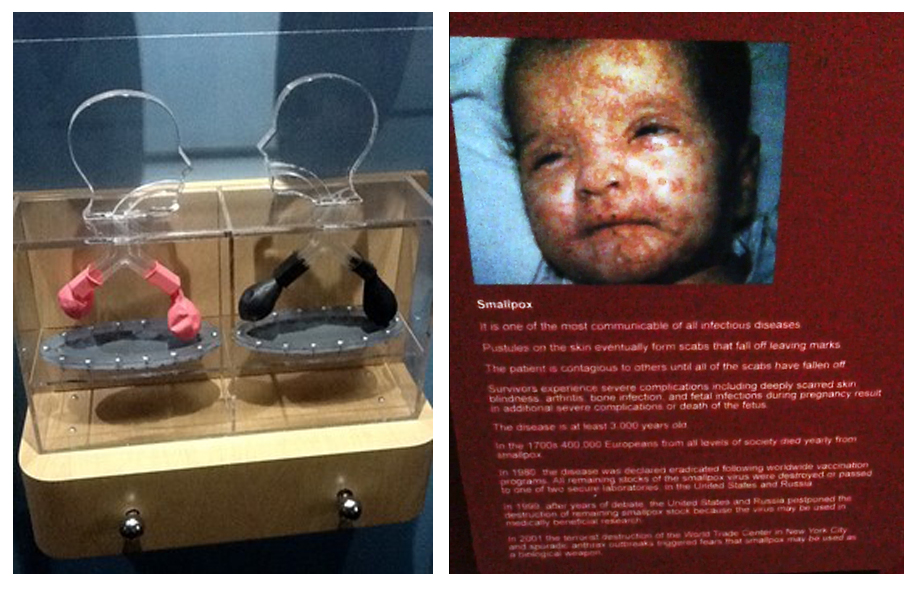
An unstated directive about abstinence and safe sex is being made by graphic photos of a cancerous cervix at the ‘Risky Relations’ exhibit. Non-verbal arguments rely on the visitor to reconstruct the argument explicitly and come to the necessary conclusions. A focus on verbal and visual instrumentalities reveals that the meaning of an image depends upon the context in which it is presented, and the social purpose for which it is intended.
Norms
https://dx.doi.org/10.15180/211605/005‘Norms’ are social rules governing a communication event, and the term refers to how speakers react to and interpret messages (Hymes, 1974, p 60). As an informal learning setting, The Museum of Science and Industry is subject to far fewer rules than a classroom, where norms of interaction include sitting still and listening intently. Self-directed learning and hands-on activities transgress norms of formal learning by design. I observed classrooms of children, unleashed upon the exhibition floor, running and emitting shrill vocalisations, pausing only long enough to haphazardly mash a panel of buttons. The Amazing You has interactive and ‘pseudo-interactive’ (Heath and Vom Lehn, 2008) affordances, including buttons to push, interactive quizzes, etc. Affordances may be considered as tacit directives because they suggest an action potential of an object without issuing a formal imperative. A steering wheel on an exhibit almost ‘asks’ to be turned, no instructions needed.
The Amazing You frankly addresses some taboo topics, and discourse usually taking place in private (between a doctor and patient, or between family members) is out in the open. Some exhibits, such as the ‘Welcome to Our World’ video, showing graphic birth footage, are partially walled off from the rest of the exhibition, with a sign, warning of adult subject matter. Another exhibit has actual foetal specimens in jars, illuminated in different colours, each foetus representing a different gestation period. One informant, a young woman without kids, expressed concern about their origins: “Presumably the fetuses died of natural causes [laughs nervously]…could it have been born prematurely but still survived?” Respondents who stated there were parts of the exhibition that were not appropriate for children cited the foetuses, the birthing video, and the STD exhibit.
For Hymes (1974), a full analysis of norms involves a broader consideration of social context (Keating, 2007, p 291). In the United States, millions of people don’t have any health insurance and millions more are inadequately insured. While private health insurance companies were major underwriters of the exhibition, there was never a mention of co-pays, deductibles and other ‘out-of-pocket’ expenses which patients in the US routinely pay. Many of the medical procedures exhibited would have been prohibitively expensive for the hundreds of thousands of uninsured and underinsured people in the greater Tampa Bay area (McGrory, 2015).
Genre
https://dx.doi.org/10.15180/211605/006Hymes (1974) uses the term ‘genre’ to distinguish between types of communication, such as lectures, sermons, tales, etc. (p 61). Certainly, science centres have generic features, such as panels with text and pictures, models, and arcade style buttons to press, which can be distinguished from a collections-based exhibition. What other ways might the genre category be applied to The Amazing You?
Executives at MOSI were keen to draw a distinction between the ‘bodily systems’ approach found in other human biology exhibits, and the life span approach at The Amazing You. The ‘you’ pronoun makes the body not an object (or an aggregate of objects) to behold, but the subject of the story. This cradle-to-grave narrative has tragic elements, with the ‘protagonist’ subject to injuries and degenerative diseases before eventually succumbing to mortality (despite their best efforts at eating healthily, exercising, etc.). As one informant stated: “What I noticed is that they jump from getting born to talking about all the diseases you can get.”
Ravelli (2006), who expands the notion of genre into multimodal environments, notes that genre encompasses function as well as form and content (p 302). This brings us back to the overall ‘ends’ of the exhibition. Are there generic constraints on what makes The Amazing You a public health intervention? This is a question for further research. Ravelli (2006) notes that component messages may combine to contribute to some macro-genre, such as when a report provides evidence for some larger social purpose (p 303). This idea seems similar to ‘act sequence’, where a series of acts are ordered to accomplish some end result. ‘Genre’ may be one of the more elusive terms in the SPEAKING mnemonic since it overlaps with some of the others.
Estimating the success of The Amazing You, and the success of SPEAKING
https://dx.doi.org/10.15180/211605/007There are two questions we are concerned with in this section, both related to success. First, how successful was The Amazing You as a public health intervention? Second, how successful was the SPEAKING mnemonic in providing insight into a science museum exhibition? Addressing the first question is limited by the way this study was designed. The research described here was not a summative evaluation, learning outcomes were not a focus, and visitors were not prompted to comment on any particular exhibit. While psychometrics were not used on the survey, the descriptive terms shown in Figure 7 (top) are mostly positive.
Under the prompt for suggestions on how the exhibition could be improved, most respondents left the field blank or stated it was fine as is, but there were complaints about non-functioning exhibits, noisiness, dim lighting and lack of staff/volunteers on the floor. Other respondents wondered if some of the exhibits were appropriate for children.
Figure 7 (bottom) shows that most respondents (around 65 per cent) thought the exhibition would have a positive influence on health behaviours, with the rest unsure or unconvinced. One respondent wrote, ‘It might or it might not. Depends on the person, really’.
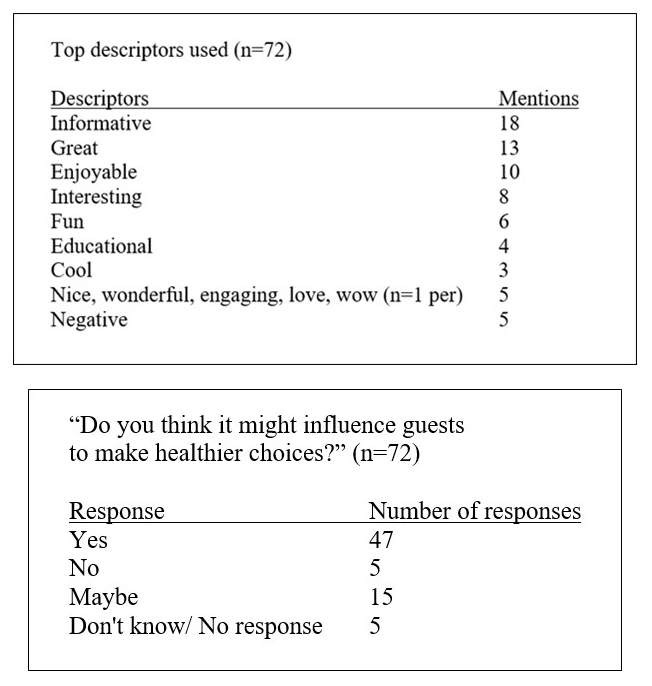
Beyond the self-reported opinions of staff and visitors, there is little evidence to support a claim about the effectiveness of The Amazing You as a public health intervention. A more longitudinal, quantitative study might have enlisted visitors for months or years, with a clinician gathering ‘before and after’ readings of weight, blood pressure and other metrics. A ‘pre, then post’ survey could be given before and ‘in several-month’ intervals after a museum visit which would have them self-report on things such as food intake, exercise and bad habits. A control group could go through the same process, except without a visit to The Amazing You, to try and control for other influences, such as doctor’s orders, family pressure or the media. Lacking funds for such an ambitious evaluation, a qualitative, ethnographic PhD dissertation resulted from this research, yielding some insights into the nature of health exhibits as interventions, which are stated below.
As to the second question about the utility of the SPEAKING mnemonic, I certainly found it useful for characterising the complex communication situation presented at The Amazing You. With its emphasis on function, SPEAKING provided the insight that health communication messages are more than statements of fact and may be didactic in their emphasis on behaviour modification. The concept of ‘act sequence’, especially, helped to reveal statements of facts which precede a command, as well as indirect commands, worded as statements. Indirect directives (verbal and pictorial) may help to mitigate the imposition of an overt command.
The SPEAKING mnemonic was devised as a tool for analysing communicative situations, and while a search of the literature hasn’t revealed any previous application to museum settings, there is nothing, in principle, preventing its use. There are some potential objections which may be anticipated. It may be objected that the mnemonic is intended for the study of speech, not writing and multimedia, but it is worth noting that originally, other forms of communication are included in the definition of instrumentality (or message form), including written language, hand gestures and facial expressions, or ‘surrogate languages’, such as whistles, drumbeats and morse code (Saville-Troike, 1989, p 145). As communicative situations, this study shows that science museum exhibitions yield to the same analytical categories as those applied to other one-way messages, such as explanations, elaborations, soliloquies or missives.[3]

Another objection that might be raised is that the study of communicative acts in sequence is usually found in the literature on face-to-face conversations (c.f. Geis, 2006). A science museum is, by contrast, a unidirectional signal path from sender to receiver. In response to this potential objection, it can first be noted that visitors do have some occasions to respond. For example, they might write reviews on travel websites, or respond to survey and interview questions posed by a guest researcher. However, the idea that communicative acts are typically sequenced in multimedia arguments seems apparent in the presentation of statement/imperative pairings, as well as the images which arguably formed elements of the sequence.
Another objection to SPEAKING, which was problematic in this research, is that the categories are overlapping and not mutually exclusive. That is, an example used to illustrate one aspect might also illustrate another. For instance, in the discussion of ‘genre’, above, it wasn’t entirely distinguishable from ‘ends’, because both related to purpose or function. The example of the disembodied head being projected onto the velvet background (pictured in Video 1), was used in the study as an illustration of keying, where the audio channel contained a sincere monologue, but the visual modality showed something surreal. This example could have also been used to illustrate two different instrumentalities, one audible, and one visual. However, if this single anecdote helped illustrate both analytical dimensions, perhaps it shows that both are apt descriptors for consideration in the science museum environment.
No doubt, more problems with this approach can be identified, but for present purposes SPEAKING was an effective methodological innovation which considered multiple dimensions of museum communication. To use SPEAKING in a multimedia science museum environment is to acknowledge that an exhibition is a communication situation, with multiple purposes at work, not limited to passing on information. To employ the SPEAKING mnemonic is also to make a statement that communication is principally a multimodal experience, and not strictly a verbal one. The goals of exhibit designers are, perhaps typically, to inform and entertain, but those in the science museum world need to also ask: What is this exhibit trying to get people to do? Certainly, there are buttons to push, or interactive quizzes to be answered. But in terms of social purpose, what actions are being recommended, even after the visitor leaves?
Conclusion
https://dx.doi.org/10.15180/211605/008The SPEAKING mnemonic characterises facets of communication taking place at The Amazing You, beyond a traditional sender/receiver model of communication, while providing access to conceptual apparatus from SAT, interactional communication theory and the dramaturgical sociology of Goffman. This piece is an intentional effort to find new ways to approach science museum exhibits. This study suggests that the SPEAKING mnemonic is amendable to being used in museums, and can be useful for identifying (the sometimes less-than-explicit) agendas of health promotion discourse.
Among the terms of SPEAKING, ‘act sequence’ was the one that provided the most insight into how reports precede commands. While The Amazing You sometimes phrases health advice in the imperative mood, it may also be phrased in the indicative. Health advice also appears after a factual claim; or, it may not be stated explicitly, but is a tacit conclusion, following from evidence presented. Pictures and other multimedia may serve as component acts, providing evidence or issuing injunctions much like syntactical sentences. Such act sequences can be identified in other forms of multimedia health promotion messages, outside of museums, such as print ads, pamphlets, commercials, PSAs, etc. Identifying covert commands is a reminder that health communication may attempt to conceal its interventionist intent. That factual assertions precede and couple with imperatives suggests a limitation of SAT, where the uttered sentence stands on its own as the unit of analysis. Instead, speech acts should be studied syntagmatically as well as paradigmatically, to follow up on Hymes’ (1974) ‘act sequence’ concept. The other notable finding of this study is that the potential scope of SPEAKING is apparently greater than its paradigmatic oral utterance cases. It can be applied to multimedia and multimodal messages, in science museums and beyond.
To have an ‘interventionist’ exhibition is to urge visitors to quit smoking, get vaccinated, lose weight, and otherwise change their behaviour. While behaviours are an important determinant of health, they are not the only one. Health communication messages may focus on individual behaviours at the expense of other health determinants, including pollution, racism, income, education, housing, and access to health care. Researchers (including those writing in The Science Museum Group Journal) sometimes question the very premise of interventions. For example, Manon Parry (2021) notes that interventions presume something in need of correction, and George Vasey (2021) notes that the notion of ‘misbehaviour’ is infantilising. A deeper question than ‘What makes an exhibition interventionist?’ is ‘What is meant by the term intervention?’. An intervention focused squarely on changing individual behaviours, I suggest, presumes health is solely a matter of choice, minimising social inequities.
This has only been a cursory investigation of the SPEAKING mnemonic and its potential as a methodological innovation. The insights of this paper may be stated as tentative maxims for curators and exhibit designers working on tomorrow’s health exhibits to consider. Museum exhibitions are communicative situations. An exhibition asks the visitor to do something, even after they leave, sometimes in covert ways. When asking visitors to do something, it is more effective to predicate your request with a reason why. The key (or tone) of an exhibition is important, as an exhibit may communicate contradictory moods on different communication channels (one serious and one farcical, for example). Visitors have expectations and science museums are governed by norms of interaction and generic constraints; both of these can be understood and anticipated to make exhibitions work well. Finally, for a deeper look at museum communication, as a tool for evaluation, it may be helpful to consider the SPEAKING mnemonic.
Acknowledgements
I am grateful to Wit Ostrenko, Dave Conley and Judith Lombana, for facilitating the Museum of Science and Industry research, and to Fred Steier, my dissertation advisor. I am also thankful for the comments from two anonymous reviewers. All photos and charts are from the author.



